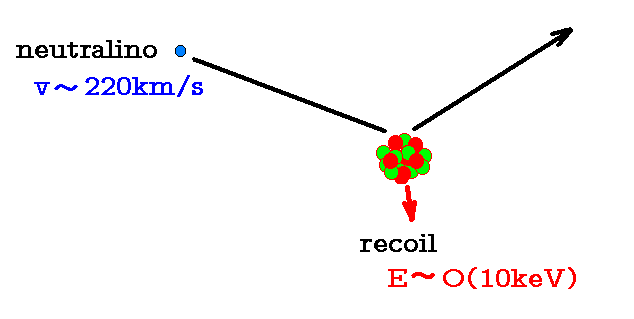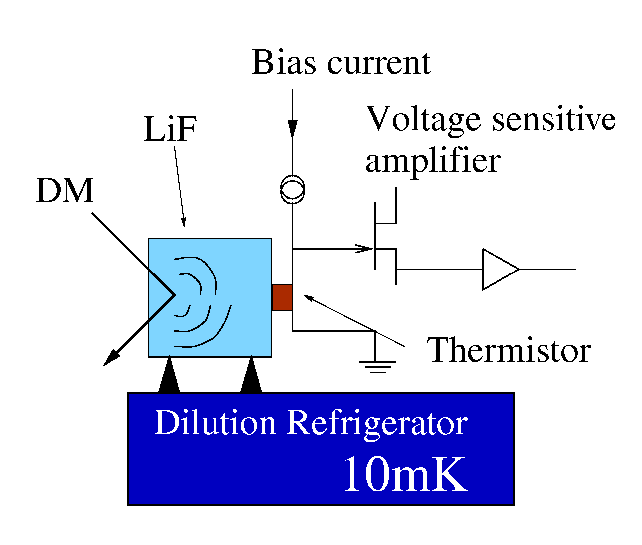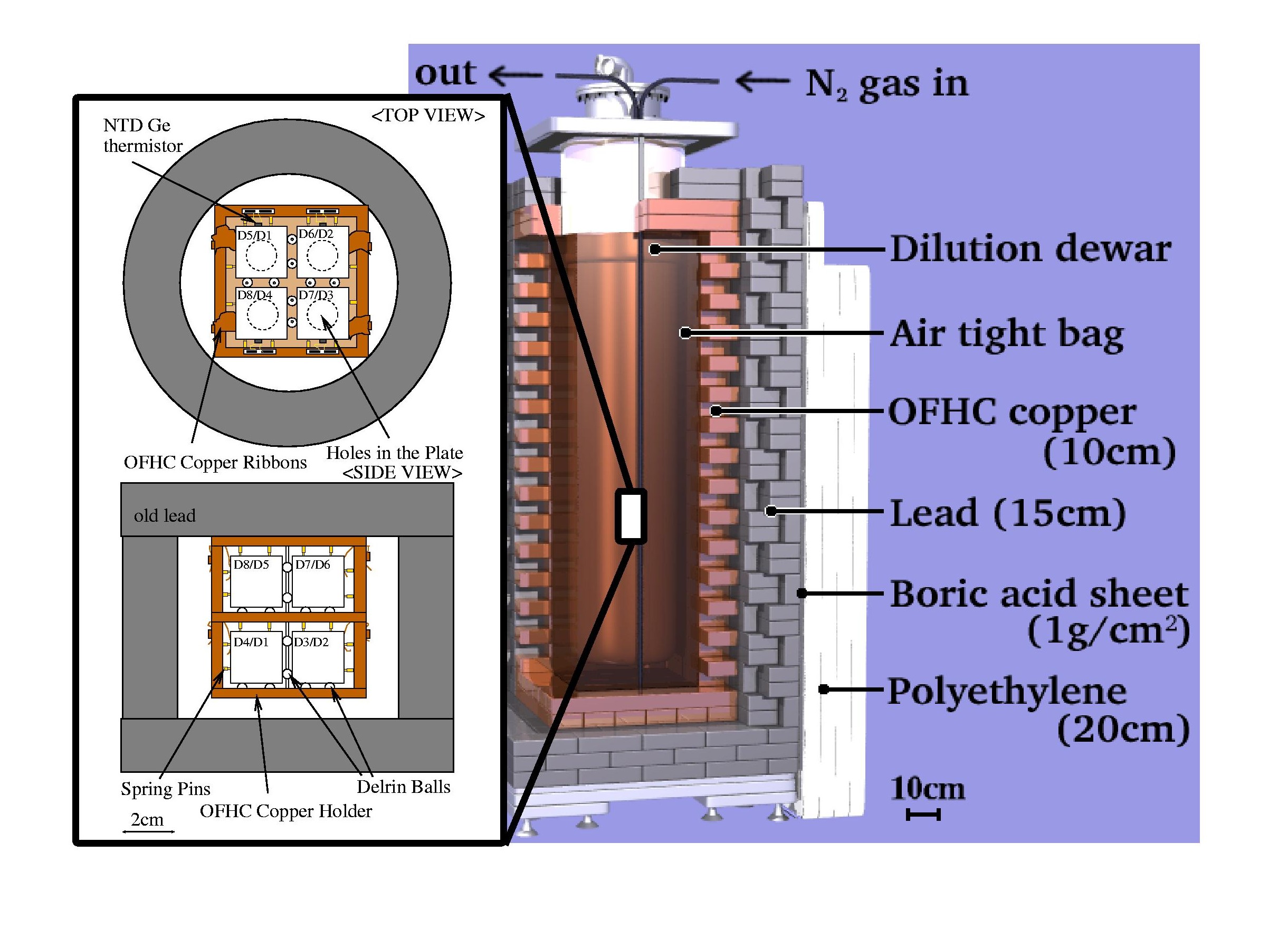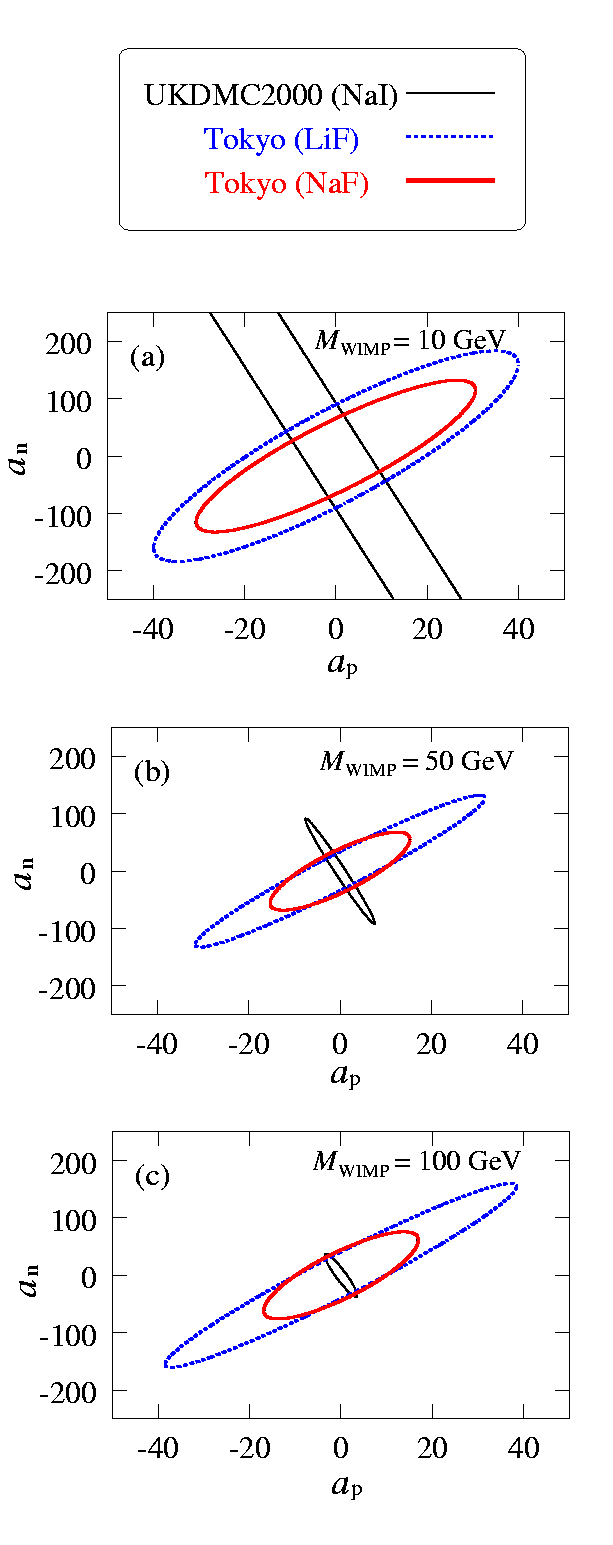
MINOWA Group |
みのわ研究室 |
Direct dark matter search experiment with a cryogenic bolometerThere is substantial observational as well as theoretical evidence that most of the matter in the universe is dark. The neutralino, a hypothetical neutral supersymmetric fermion, is considered to be the most probable candidate for the dark matter. The velocity of the dark matter particle has a Maxwellian distribution with an rms velocity of about 220 km/s. The neutralino detection is not straightforward but done in two steps. If a neutralino collides with a nucleus in ordinary matter, the nucleus recoils with kinetic energy of order 10keV. The recoil nucleus is then detected by a charged particle detector. The nuclear recoil detection method is widely used in the dark matter search experiments. |
ボロメータ(熱量計)による暗黒物質の直接検出実験我々の宇宙には通常の物質よりはるかにたくさんの光らない物質があることを示唆する観測的および理論的根拠が数多くある。この物質は暗黒物質(ダークマター)と呼ばれており、その正体は素粒子の超対称性理論の予言する粒子ニュートラリーノである可能性が高い。太陽系近傍の暗黒物質粒子は二乗平均速度およそ220 km/sのマクスウエル分布に従う速度で運動していると考えられている。 ニュートラリーノは電気的に中性なので、検出は直接ではなく、二段階の過程となる。ニュートラリーノが通常の原子核と弾性散乱を行なうと原子核は10keV程度の反跳エネルギーを受ける。この反跳原子核を荷電粒子検出器で検出するのが暗黒物質検出のやり方である。 |

| We developed a bolometer for
the direct dark matter search experiment with the nuclear
recoil detection method. The bolometer is a kind of
calorimeter made of an energy absorber and a sensitive
thermistor attached on it both cooled down to a
temperature of about 10mK. If a neutralino comes into the
absorber and drops a fraction of its energy by a
collision with a nucleus in it, then the temperature
increases slightly and the resistance of the thermistor
changes. The resistance change can be electronically read
out with appropriate bias current and a low noise
amplifier. Energy threshold of the bolometer is generally
lower than that of ordinary particle detectors, and
therefore advantageous for the dark matter detection. We use lithium fluoride crystal for the absorber because the nuclide 19F, natural abundance of which is 100%, is theoretically predicted to have a maximal elastic scattering cross section with the spin dependently interacting neutralinos. We use eight pieces of LiF and NaF crystal, each of which weighs 20 grams. The bolometer is suitable for the dark matter detection in this respect, too, because a wide range of material with any nuclides can be used for the absorber as far as its specific heat is low enough at the low temperature, while nuclides contained in ordinary particle detectors are restricted within narrow limits. |
我々はこの反応を利用し暗黒物質ニュートラリーノを直接検出するために、ボロメーターを開発し、実験を行なっている。次の図に示すように、ボロメーターは10mK程度に冷却した吸収体とそれに取り付けられた高感度抵抗温度計(サーミスター)からなる極低温熱量計型検出器である。10keV程度のエネルギーによる吸収体の温度上昇をサーミスターにより電気信号に変換するというのがボロメーターを用いたニュートラリーノ検出の原理である。通常の検出器よりもエネルギーの検出閾値が低いと言う特徴がある。 吸収体に用いている原子核19Fはそのスピン構造から、スピンに依存した相互作用を行なうニュートラリーノに対し非常に大きな弾性散乱断面積を持つと考えられており、19F (自然存在比100%)を含んだ検出器は暗黒物質ニュートラリーノの探索には非常に有利である。我々は20gのフッ化リチウムLiF、およびフッ化ナトリウムNaFの単結晶を吸収体として8個並べて用いている。 ボロメータは通常の検出器と異なり、極低温で比熱の小さな物質ならば何でも吸収体として採用できるので、暗黒物質検出器として最適である。 |

| The bolometer is installed
in an underground laboratory of Kamioka Observatory,
ICRR, Univ. of Tokyo to avoid background caused by cosmic
rays. The observatory is placed at 1,000 m underground of
Mozumi Mine of the Kamioka Mining and Smelting Co.
located in Kamioka-cho, Gifu, Japan. As shown in the
following figure, the bolometer is set up in a dilution
refrigerator to cool down the crystals and thermistors.
The refrigerator is surrounded by heavy radiation shield
made of oxygen free high conductivity copper, lead, and
so on to get rid of the background of environmental
natural radio activity. The laboratory is equipped with a
compact helium liquefier and a liquid nitrogen generator
to help the long term operation of the dilution
refrigerator without any cryogen supply from outside of
the mine. As radioactive radon gas concentration is relatively high in the Kamioka mine, the space between the refrigerator and the copper shield is purged of the radon gas by putting a plastic bag filled with nitrogen gas evaporated from the liquid nitrogen. Moreover, fresh air is introduced from the outside of the mine thorough a duct into the laboratory with a help of a charcoal radon eliminator. |
観測は、宇宙線の影響を避けて岐阜県神岡鉱山内にある、東京大学宇宙線研究所神岡宇宙素粒子研究施設の地下実験室で行なわれている。ボロメータは下図のように、極低温にするための希釈冷凍機の中に収められている。希釈冷凍機の外側は、環境の自然放射線の侵入を防ぐための無酸素銅、鉛などの重遮蔽がとり囲んでいる。実験室には、希釈冷凍機の運転に必要なヘリウム再凝縮装置、液体窒素製造装置なども設置されており、寒剤の補給なしに長時間運転ができる。 神岡鉱山内は空気中の放射性ラドンガス濃度が高いことが知られているので、希釈冷凍機近傍にラドンが入り込まないようにするためのガスバッグを設置し、その中にはラドン濃度の低い液体窒素製造装置からの蒸発ガスを流している。また、坑外からラドンガス濃度の低い新鮮な外気をダクトにより実験室に導入し、さらに残留するラドンガスの除去のために活性炭による除去装置を製作して設置している。 |

| In the latest publication, we derived the limits to the spin dependently interacting neutralinos in the ap-an (neutralino-proton and neutralino-neutron couplings) plane and excluded a large part of the parameter space allowed by the UK Dark Matter Collaboration experiment, which gave one of the best upper limits to the interaction cross section of the spin dependently interacting neutralinos. See the following figure. | これまでの観測の結果、下に示すようにスピンに依存した相互作用を行なうニュートラリーノに対しap-anパラメータ(ニュートラリーノと陽子およびニュートラリーノと中性子の結合定数)平面で制限を与えたが、これまで最良の制限を与えていたUK Dark Matter Collaboration の制限をさらに強める結果となっている。詳しくは、最近の論文を参照。 |

Last maintained
on 2004-02-03